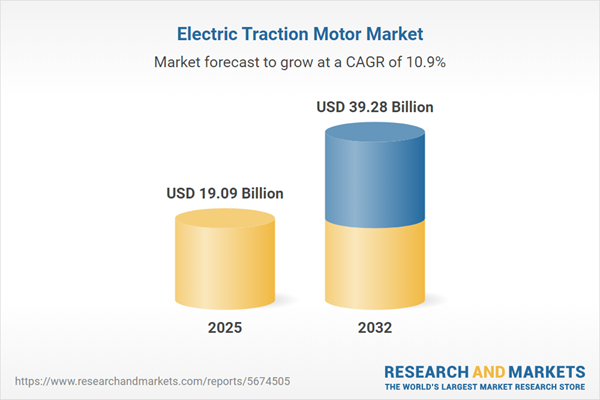Speak directly to the analyst to clarify any post sales queries you may have.
The electric traction motor market is at a pivotal stage, presenting senior leaders with opportunities to implement adaptive business models as propulsion technology and regulatory demands rapidly evolve. Effective strategies now focus on leveraging innovative engineering and operational agility to maintain performance and compliance in dynamic global transportation environments.
Market Snapshot: Electric Traction Motor Market Performance
The electric traction motor market has seen significant growth, expanding from USD 17.19 billion to USD 19.09 billion over the past year. Industry forecasts anticipate this upward trend to continue, with market value projected to reach USD 39.28 billion by 2032. Growth drivers include stricter global transportation standards, widespread integration of advanced power electronics, and prioritization of low-emission mobility. Organizations are increasingly adopting traction motors across commercial fleets, passenger vehicles, and two-wheelers, motivated by the need for operational savings and environmental benefits. Flexibility in procurement remains crucial as enterprises navigate changing policies and global compliance expectations.
Scope & Segmentation in the Electric Traction Motor Market
- Vehicle Types: Encompasses buses, commercial trucks, light-duty trucks, passenger cars, and two-wheelers. These segments address core operational needs in city transit, logistics, and specialized fleet services.
- Motor Types: Includes induction motors, ferrite permanent magnet synchronous motors, rare earth permanent magnet synchronous motors, switched reluctance motors, and wound rotor synchronous motors. Each type supports unique load profiles and efficiency targets.
- Power Ratings: Covers sub-75 kW, mid-range motors, and units exceeding 300 kW, enabling tailored deployment for both routine and heavy-duty tasks across fleet sizes.
- Cooling Types: Features air- and liquid-cooled systems to ensure robust thermal management, vital for reliability in diverse climates and operating conditions.
- Construction Types: Offers central-mounted, in-wheel, hub, and ring motor configurations, providing essential flexibility for original equipment or retrofit applications.
- Voltage Levels: Spans low, medium, and high voltage, ensuring alignment with battery innovations and next-generation control systems.
- Regional Coverage: Includes North America, Latin America, Europe, Middle East, Africa, and Asia-Pacific, each with region-specific policy requirements and infrastructure maturity impacting deployment pace and investment strategy.
- Major Companies Analyzed: Analysis encompasses CRRC Corporation Limited, Siemens Aktiengesellschaft, ABB Ltd, Alstom SA, Wabtec Corporation, Mitsubishi Electric Corporation, Toshiba Corporation, Hitachi Ltd., Nidec Corporation, and BorgWarner Inc. These firms help shape industry benchmarks and leadership in technology advancement.
Key Takeaways for Strategic Decision-Makers
- Electric traction motors are reshaping sustainable fleet development, guiding leaders toward agile compliance frameworks in an era of heightened environmental expectations.
- Innovations in materials and precise motor engineering are lengthening product lifespan and optimizing maintenance cycles, directly supporting efficient operation of large fleets.
- Predictive analytics and artificial intelligence are elevating fleet management, enabling proactive diagnostics and minimizing unscheduled downtime through real-time performance insights.
- Global and regional supply chain synchronization enhances component consistency and compliance, supporting organizations with multi-site operations and varied fleet compositions.
- Modular drivetrain and motor architectures provide adaptability for future upgrades, facilitating seamless adoption of evolving standards and business priorities.
- Regionally tailored sourcing strategies enable organizations to adjust swiftly to shifting regulatory landscapes and trade requirements, maintaining operational momentum.
Tariff Impact on Electric Traction Motor Supply Chains
Recent updates to U.S. tariff policies are reshaping procurement strategies, with manufacturers and fleet operators increasingly favoring domestic suppliers and nearshoring to reduce exposure to market volatility. This transition supports supply chain stability and predictable production schedules, while fostering resilience against unforeseen trade or currency fluctuations. As a result, flexible procurement and adaptive sourcing practices are now central to successful fleet management.
Methodology & Data Sources
This analysis draws on comprehensive secondary research and direct interviews with fleet supply chain managers and OEM executives. Scenario-based forecasting provides support for procurement and risk management teams tackling diverse, multi-regional fleet operations across key business sectors.
Why This Report Matters: Electric Traction Motor Market
- Supports proactive risk identification and mitigation, ensuring continuity and operational resilience for evolving fleets.
- Helps decision-makers assess the impact of new technologies, regulatory developments, and regional market shifts on business planning and investment strategies.
- Supplies critical intelligence for continued compliance and supply chain efficiency in rapidly transforming regulatory landscapes.
Conclusion
Strategically integrating advanced traction motor technologies empowers organizations to ensure regulatory alignment and workforce efficiency. Access to actionable market insights enhances planning capabilities and bolsters resilience for long-term fleet performance.
Additional Product Information:
- Purchase of this report includes 1 year online access with quarterly updates.
- This report can be updated on request. Please contact our Customer Experience team using the Ask a Question widget on our website.
Table of Contents
3. Executive Summary
4. Market Overview
7. Cumulative Impact of Artificial Intelligence 2025
Companies Mentioned
The companies profiled in this Electric Traction Motor market report include:- CRRC Corporation Limited
- Siemens Aktiengesellschaft
- ABB Ltd
- Alstom SA
- Wabtec Corporation
- Mitsubishi Electric Corporation
- Toshiba Corporation
- Hitachi, Ltd.
- Nidec Corporation
- BorgWarner Inc.
Table Information
| Report Attribute | Details |
|---|---|
| No. of Pages | 180 |
| Published | November 2025 |
| Forecast Period | 2025 - 2032 |
| Estimated Market Value ( USD | $ 19.09 Billion |
| Forecasted Market Value ( USD | $ 39.28 Billion |
| Compound Annual Growth Rate | 10.8% |
| Regions Covered | Global |
| No. of Companies Mentioned | 11 |









